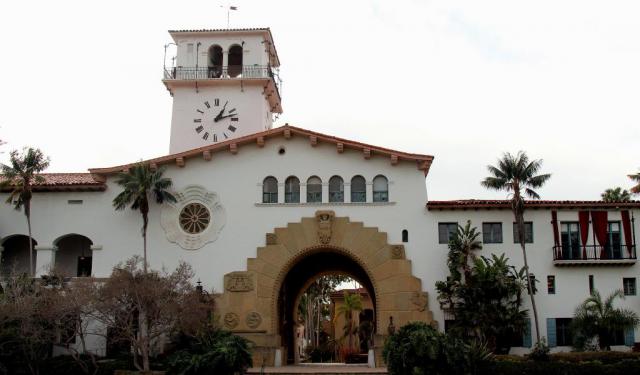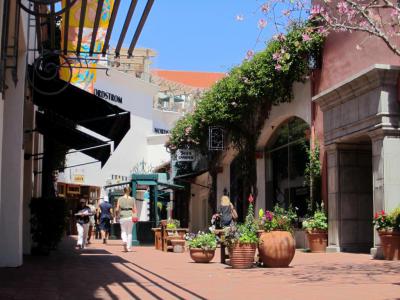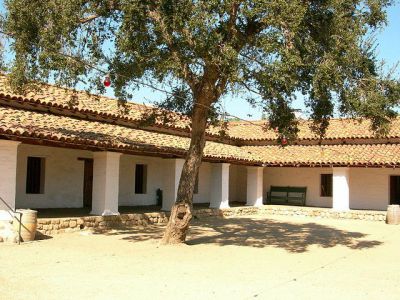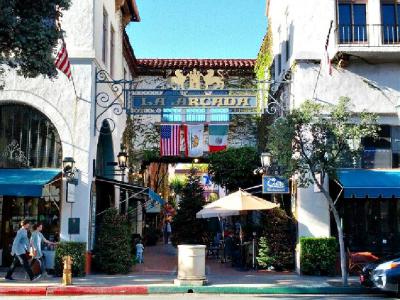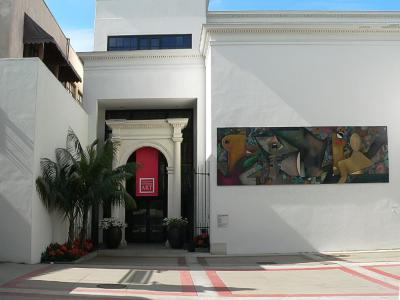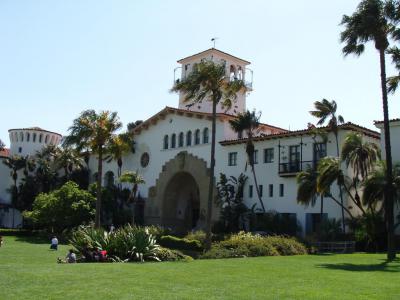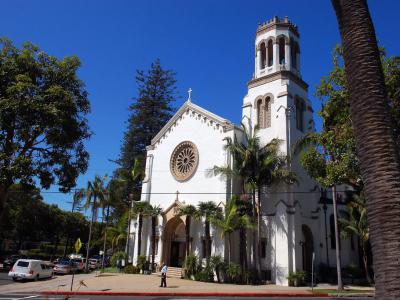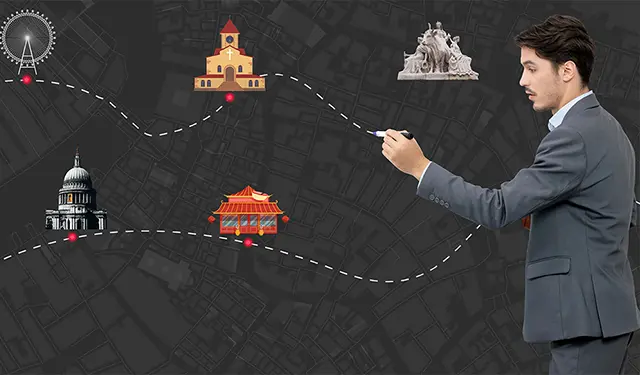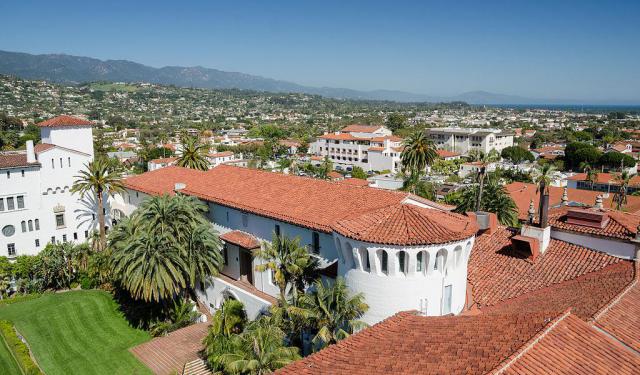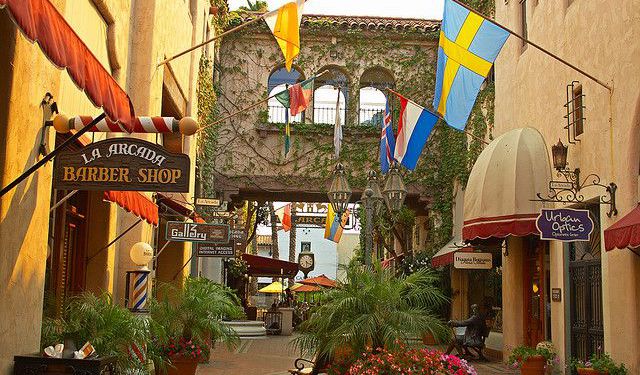Historical Buildings Walking Tour (Self Guided), Santa Barbara
Ranking as one of the most attractive places on earth, if only in terms of climate and geography alone, Santa Barbara boasts a wealth of historic architecture tastefully and seamlessly accommodated into the city's modern-day incarnation. To a first-time visitor to Santa Barbara, even the most cursory observation reveals the predominant role that these historic locations play in the identity and character of the city.
Paseo Nuevo, located in the heart of downtown Santa Barbara, is a charming shopping and dining destination that seamlessly blends modern amenities with Spanish-style architecture.
Casa de La Guerra, a historic adobe mansion, serves as a window to Santa Barbara's early Spanish colonial era. It was once the residence of José de la Guerra, a prominent figure in the region's history, and is now a museum open to the public.
Oreña Adobes features a collection of adobe structures that harken back to the 19th century. These adobes provide insight into the daily life of early Californians and showcase the region's architectural history.
The Hill-Carrillo Adobe, another historic adobe building, stands as a testament to Santa Barbara's Hispanic heritage and is also a listed property.
La Arcada Historic Courtyard, with its Spanish-style architecture, offers a picturesque setting for shopping and dining. It's a prime example of how the city preserves its historical charm.
The Santa Barbara Museum of Art houses a remarkable collection of art from various periods and cultures, offering an artistic journey through time.
The Santa Barbara Public Library is a more modern facility that pays homage to the city's architectural traditions, blending contemporary design with elements of the past.
The Santa Barbara County Courthouse is an iconic landmark, known for its stunning Spanish-Moorish architecture and beautifully landscaped sunken gardens.
Our Lady of Sorrows Church and Trinity Episcopal Church are two historic places of worship, representing Santa Barbara's diverse religious scene.
Together, all these sites tell the story of Santa Barbara's evolution over the years. If you wish to learn more about it and explore some of the key historic buildings that have made Santa Barbara a household name, synonymous with an idyllic appeal, take this self-guided walk!
Paseo Nuevo, located in the heart of downtown Santa Barbara, is a charming shopping and dining destination that seamlessly blends modern amenities with Spanish-style architecture.
Casa de La Guerra, a historic adobe mansion, serves as a window to Santa Barbara's early Spanish colonial era. It was once the residence of José de la Guerra, a prominent figure in the region's history, and is now a museum open to the public.
Oreña Adobes features a collection of adobe structures that harken back to the 19th century. These adobes provide insight into the daily life of early Californians and showcase the region's architectural history.
The Hill-Carrillo Adobe, another historic adobe building, stands as a testament to Santa Barbara's Hispanic heritage and is also a listed property.
La Arcada Historic Courtyard, with its Spanish-style architecture, offers a picturesque setting for shopping and dining. It's a prime example of how the city preserves its historical charm.
The Santa Barbara Museum of Art houses a remarkable collection of art from various periods and cultures, offering an artistic journey through time.
The Santa Barbara Public Library is a more modern facility that pays homage to the city's architectural traditions, blending contemporary design with elements of the past.
The Santa Barbara County Courthouse is an iconic landmark, known for its stunning Spanish-Moorish architecture and beautifully landscaped sunken gardens.
Our Lady of Sorrows Church and Trinity Episcopal Church are two historic places of worship, representing Santa Barbara's diverse religious scene.
Together, all these sites tell the story of Santa Barbara's evolution over the years. If you wish to learn more about it and explore some of the key historic buildings that have made Santa Barbara a household name, synonymous with an idyllic appeal, take this self-guided walk!
How it works: Download the app "GPSmyCity: Walks in 1K+ Cities" from Apple App Store or Google Play Store to your mobile phone or tablet. The app turns your mobile device into a personal tour guide and its built-in GPS navigation functions guide you from one tour stop to next. The app works offline, so no data plan is needed when traveling abroad.
Historical Buildings Walking Tour Map
Guide Name: Historical Buildings Walking Tour
Guide Location: USA » Santa Barbara (See other walking tours in Santa Barbara)
Guide Type: Self-guided Walking Tour (Sightseeing)
# of Attractions: 10
Tour Duration: 2 Hour(s)
Travel Distance: 2.0 Km or 1.2 Miles
Author: sabrina
Sight(s) Featured in This Guide:
Guide Location: USA » Santa Barbara (See other walking tours in Santa Barbara)
Guide Type: Self-guided Walking Tour (Sightseeing)
# of Attractions: 10
Tour Duration: 2 Hour(s)
Travel Distance: 2.0 Km or 1.2 Miles
Author: sabrina
Sight(s) Featured in This Guide:
- Paseo Nuevo
- Casa de La Guerra
- Oreña Adobes
- Hill–Carrillo Adobe
- La Arcada Historic Courtyard
- Santa Barbara Museum of Art
- Santa Barbara Public Library
- Santa Barbara County Courthouse
- Our Lady of Sorrows Church
- Trinity Episcopal Church
1) Paseo Nuevo (must see)
Paseo Nuevo is where history meets a shopping spree, blending old-world charm with a modern twist. Opened in 1990, this open-air center is draped in Spanish Colonial Revival style, making you feel like you’re wandering through a vintage postcard. With 458,000 square feet of space and pedestrian-friendly paths, it’s easy to wander, browse, and pretend you’re in a shopping dream. Over 50 stores-including the likes of Sephora, Victoria’s Secret, and American Eagle-sit alongside local treasures like Angie’s Boutique and Maker's Market. In short, it’s a retail wonderland.
But hold onto your shopping bags-there’s more than just retail therapy here. Grab a quick bite at California Pizza Kitchen or indulge in gourmet burgers at Eureka! Your taste buds will be just as entertained. If you're a sweet tooth, Le Macaron’s French pastries, Oak Berry’s acai bowls, and Pressed Juicery’s fresh juice will keep you happily snacking. For those who crave culture with their shopping, the Museum of Contemporary Art is just upstairs, and the center hosts outdoor markets and kids’ activities to keep everyone entertained.
Come to think of it, Paseo Nuevo isn’t just a place to shop-it’s where shopping, dining, and culture blend seamlessly in the best way possible. Nestled in the historic Paseo de la Guerra complex (yep, it’s on the National Register of Historic Places), it’s got more history than your high school textbook and more fun than you can shake a shopping bag at. You’re guaranteed an experience that’s anything but run-of-the-mill-prepare for something truly remarkable!
But hold onto your shopping bags-there’s more than just retail therapy here. Grab a quick bite at California Pizza Kitchen or indulge in gourmet burgers at Eureka! Your taste buds will be just as entertained. If you're a sweet tooth, Le Macaron’s French pastries, Oak Berry’s acai bowls, and Pressed Juicery’s fresh juice will keep you happily snacking. For those who crave culture with their shopping, the Museum of Contemporary Art is just upstairs, and the center hosts outdoor markets and kids’ activities to keep everyone entertained.
Come to think of it, Paseo Nuevo isn’t just a place to shop-it’s where shopping, dining, and culture blend seamlessly in the best way possible. Nestled in the historic Paseo de la Guerra complex (yep, it’s on the National Register of Historic Places), it’s got more history than your high school textbook and more fun than you can shake a shopping bag at. You’re guaranteed an experience that’s anything but run-of-the-mill-prepare for something truly remarkable!
2) Casa de La Guerra
Casa de la Guerra is a historic adobe residence built between 1818 and 1828 by José de la Guerra, the fifth comandante of the Presidio and a key figure in early California. Originally designed as a one-story U-shaped structure with a tiled roof, the house served as the social, political, and cultural hub of the city during the Mexican era. Despite post-1857 repairs and early 20th-century changes, the original character remains largely intact. Inside, the museum displays original furnishings and exhibits on the de la Guerra family and Hispanic heritage, with two rooms for rotating themes like architectural conservation and 19th-century life.
The surrounding Paseo de la Guerra complex, developed over time, includes interconnected courtyards and supporting structures. Casa de la Guerra also includes a gift shop featuring items tied to the region’s culture and history, such as books, puzzles, local chocolate, honey, and olive oil. While the exterior remains accessible at all times, the museum’s interior opens on weekends for those interested in exploring the restored adobe firsthand.
The surrounding Paseo de la Guerra complex, developed over time, includes interconnected courtyards and supporting structures. Casa de la Guerra also includes a gift shop featuring items tied to the region’s culture and history, such as books, puzzles, local chocolate, honey, and olive oil. While the exterior remains accessible at all times, the museum’s interior opens on weekends for those interested in exploring the restored adobe firsthand.
3) Oreña Adobes
Completed in 1849, the Oreña Adobe originally served as a warehouse supporting the coastal trade. Its thick adobe walls and red-tiled roof follow the Spanish Colonial building tradition still visible in the region. In 1858, the structure was expanded into a one-and-a-half-story residence, following its purchase by Gaspar Oreña. That addition shifted its use from storage to family home, a role it retained for generations. A further renovation in the 1920s introduced a rear extension and patio, blending newer features into the historic framework.
The adobe’s exterior remains its most defining feature, with earthen walls formed from natural clay bricks and restrained detailing consistent with its construction period. The color palette-muted earth tones against curved roof tiles-anchors the building in the architectural language of early California. A scroll-shaped historical marker installed on-site provides a brief timeline of ownership and function, standing out from typical signage with its curled form.
The adobe’s exterior remains its most defining feature, with earthen walls formed from natural clay bricks and restrained detailing consistent with its construction period. The color palette-muted earth tones against curved roof tiles-anchors the building in the architectural language of early California. A scroll-shaped historical marker installed on-site provides a brief timeline of ownership and function, standing out from typical signage with its curled form.
4) Hill–Carrillo Adobe
The Hill–Carrillo Adobe was initially the home of a merchant named Daniel Hill and his wife, Rafaela Luisa Ortega. The couple occupied the house from 1826 to the early 1830s. The Hills sold the home to John Wilson and his wife, Ramona Carillo Pacheco. As the couple's home, the house became a major social center for many years.
In the 20th century, the house had diverse uses that included a Chinese laundry and school, as well as a dentist's office. Esher Fiske Hammond bought the property in 1916 after the building had started to fall into a state of disrepair. Two wings added to the building provided a book illumination studio for Robert Wilson Hyde.
The Hutton Parker Foundation has owned the property since 2010. One of the functions the adobe has served is being a free meeting space for local non-profits. In 2019, the Foundation started a renovation. This adobe is a California Historic Landmark, City of Santa Barbara Landmark, and is also on the National Register of Historic Places.
In the 20th century, the house had diverse uses that included a Chinese laundry and school, as well as a dentist's office. Esher Fiske Hammond bought the property in 1916 after the building had started to fall into a state of disrepair. Two wings added to the building provided a book illumination studio for Robert Wilson Hyde.
The Hutton Parker Foundation has owned the property since 2010. One of the functions the adobe has served is being a free meeting space for local non-profits. In 2019, the Foundation started a renovation. This adobe is a California Historic Landmark, City of Santa Barbara Landmark, and is also on the National Register of Historic Places.
5) La Arcada Historic Courtyard
La Arcada Historic Courtyard is a captivating blend of art, shopping, dining, and historical charm. Established in 1926 in the Spanish Revival style, the space is designed for leisurely exploration. Visitors can enjoy tile-lined walkways, fountains, and sculptures that enhance the peaceful atmosphere. The iconic clock tower, inspired by a famous Chicago clock, stands out as one of the courtyard's key architectural highlights. Along with these, visitors can admire realistic statues, including playful bronze dolphins and a turtle fountain, perfect for snapping photos and interacting with the art.
The courtyard offers a diverse range of shopping options. Boutiques feature unique clothing, jewelry, home decor, and art, with local galleries showcasing paintings, sculptures, and historical artifacts by both established and emerging artists. For something out of the ordinary, the historic barbershop displays antique equipment, adding a quirky touch to your visit.
After some time spent browsing and exploring, a meal at one of the nearby eateries becomes a well-earned pleasure-perhaps Danish pastries from Andersen’s Bakery or the distinctive blend of French and Ethiopian flavors at Petit Valentien. The area also offers a variety of other dining choices, from California cuisine to Italian dishes and decadent French chocolate, ensuring there’s something to satisfy every taste.
The courtyard offers a diverse range of shopping options. Boutiques feature unique clothing, jewelry, home decor, and art, with local galleries showcasing paintings, sculptures, and historical artifacts by both established and emerging artists. For something out of the ordinary, the historic barbershop displays antique equipment, adding a quirky touch to your visit.
After some time spent browsing and exploring, a meal at one of the nearby eateries becomes a well-earned pleasure-perhaps Danish pastries from Andersen’s Bakery or the distinctive blend of French and Ethiopian flavors at Petit Valentien. The area also offers a variety of other dining choices, from California cuisine to Italian dishes and decadent French chocolate, ensuring there’s something to satisfy every taste.
6) Santa Barbara Museum of Art (must see)
Founded in 1941, this museum is housed in a building that once served as the city’s post office, but now it’s all about serving up artistic masterpieces. With over 5,000 years of art history on display, you’ll find everything from Monet and Van Gogh to Degas, not to mention an impressive collection of Chinese art-think of it as a cultural adventure without the need for a passport.
But the experience doesn’t end with the classics. With rotating exhibits, there’s always something fresh to explore, from paintings and sculptures to ceramics. The museum is also a champion of emerging artists, so you might just discover the next big name before anyone else. Want to dive deeper? Join a docent-led tour or get hands-on in a workshop-because why settle for just admiring when you can roll up your sleeves and dive into creativity?
Need a break? Swing by the Museum Shop for quirky souvenirs or art books that’ll have you sounding like a genius at your next dinner party. Feeling hungry? Head to the café for light snacks, because even the most dedicated art lover deserves a little recharge. And if you’re in the mood for something more exclusive, the museum’s 154-seat auditorium is perfect for special events. Also, don't forget the library-packed with 50,000 books and 55,000 slides, it's a goldmine for the curious.
Ultimately, with its affordable admission and constantly rotating exhibits, this museum is a must-experience for anyone who’s into art, history, and a dash of surprise.
But the experience doesn’t end with the classics. With rotating exhibits, there’s always something fresh to explore, from paintings and sculptures to ceramics. The museum is also a champion of emerging artists, so you might just discover the next big name before anyone else. Want to dive deeper? Join a docent-led tour or get hands-on in a workshop-because why settle for just admiring when you can roll up your sleeves and dive into creativity?
Need a break? Swing by the Museum Shop for quirky souvenirs or art books that’ll have you sounding like a genius at your next dinner party. Feeling hungry? Head to the café for light snacks, because even the most dedicated art lover deserves a little recharge. And if you’re in the mood for something more exclusive, the museum’s 154-seat auditorium is perfect for special events. Also, don't forget the library-packed with 50,000 books and 55,000 slides, it's a goldmine for the curious.
Ultimately, with its affordable admission and constantly rotating exhibits, this museum is a must-experience for anyone who’s into art, history, and a dash of surprise.
7) Santa Barbara Public Library
The Santa Barbara Public Library is in a building constructed in 1930 that saw a remodeling and expansion from 1979 to 1980. As a part of the Black Gold Library Consortium, the library has an extensive collection that saw over 1,000,000 items circulated in 2017.
Elaborate carvings in a Spanish style grace the front door. A courtyard area between the gallery wings offers a peaceful place to enjoy some sunshine. The Gallery areas are bright and open, allowing in plenty of light to draw attention to the art.
This library is host to the Faulkner East and West Galleries and Faulkner Memorial Art Gallery. All of these galleries host art selected through a juried process on an annual basis. Many of the works on display feature local artists who are relatively unknown.
The library has a variety of activities for all ages going on at any given time. Storytime activities for kids, book clubs, and Spanish conversation groups are popular activities available.
Elaborate carvings in a Spanish style grace the front door. A courtyard area between the gallery wings offers a peaceful place to enjoy some sunshine. The Gallery areas are bright and open, allowing in plenty of light to draw attention to the art.
This library is host to the Faulkner East and West Galleries and Faulkner Memorial Art Gallery. All of these galleries host art selected through a juried process on an annual basis. Many of the works on display feature local artists who are relatively unknown.
The library has a variety of activities for all ages going on at any given time. Storytime activities for kids, book clubs, and Spanish conversation groups are popular activities available.
8) Santa Barbara County Courthouse (must see)
The Santa Barbara County Courthouse is often called one of the most stunning public buildings in the U.S.-and for once, that kind of praise isn’t just brochure talk. Built in 1929 after the original 1872 version was leveled by an earthquake, the city didn’t just rebuild but seized the moment and went full architectural drama. The result was a bold embrace of Spanish Colonial Revival style, featuring red-tiled roofs, hand-painted tiles, white stucco walls, and arches with serious charm. Architect William Mooser III wasn’t shy about ambition, and it shows. This place takes up an entire city block and still serves as a working courthouse, though you'd be forgiven for assuming you accidentally wandered into a Mediterranean film set.
One of its top features is the El Mirador Clock Tower, soaring 85 feet and offering a panoramic sweep of Santa Barbara-from tiled rooftops to the Pacific blues and the rolling Santa Ynez Mountains. Its best part is an elevator, so no heroic stair-climbing required.
Then there’s the Mural Room, a former courtroom turned ceremonial showpiece. More than 4,000 square feet of murals by Dan Sayre Groesbeck kick the city’s early history into vivid gear-dramatic, detailed, and perfect for those who prefer their history served with a side of artistic swagger.
Outside, the vibe holds strong. The Sunken Garden, planted where the old courthouse once stood, is now a favorite for outdoor concerts and sun-soaked lounging. And the Spirit of the Ocean Fountain, dating back to 1927, keeps the scene playful with sculpted figures flanking a dolphin that exudes timeless confidence.
With its mix of grand design, historical storytelling, and unexpected flair at every turn, the Santa Barbara County Courthouse proves that not all government buildings are built equal-some are built to be admired...
One of its top features is the El Mirador Clock Tower, soaring 85 feet and offering a panoramic sweep of Santa Barbara-from tiled rooftops to the Pacific blues and the rolling Santa Ynez Mountains. Its best part is an elevator, so no heroic stair-climbing required.
Then there’s the Mural Room, a former courtroom turned ceremonial showpiece. More than 4,000 square feet of murals by Dan Sayre Groesbeck kick the city’s early history into vivid gear-dramatic, detailed, and perfect for those who prefer their history served with a side of artistic swagger.
Outside, the vibe holds strong. The Sunken Garden, planted where the old courthouse once stood, is now a favorite for outdoor concerts and sun-soaked lounging. And the Spirit of the Ocean Fountain, dating back to 1927, keeps the scene playful with sculpted figures flanking a dolphin that exudes timeless confidence.
With its mix of grand design, historical storytelling, and unexpected flair at every turn, the Santa Barbara County Courthouse proves that not all government buildings are built equal-some are built to be admired...
9) Our Lady of Sorrows Church
Our Lady of Sorrows Church is no ordinary place of worship-it’s a bona fide landmark steeped in history and cultural charm. While the building you see today dates back to 1929, the church’s story kicks off in 1891 when it stepped up from a humble chapel to become a central gathering place for the community. By 2016, it earned its official landmark status-a fancy way of saying, “This place matters.”
Architecturally, the church is like a stylish mash-up of Gothic Revival drama and Spanish Colonial cool, perfectly in sync with the city’s historic vibe. Visitors often find themselves craning their necks to admire ceilings so high and grand, they’d give many cathedrals a run for their money. The stained glass windows aren’t just decoration-they’re like colorful storytellers, painting scenes from Christ’s life and the saints, turning sunshine into a kaleidoscope of light. The star of the show is a stunning rose window above the main altar that bathes the nave in a warm, golden gleam.
Outside, the church is framed by lush gardens sprinkled with roses and blooms that practically beg for a photo op-or a quiet stroll. The elegant bell tower and intricate carvings add just the right touch of old-world charm, making it a magnet for shutterbugs and history buffs alike.
But don’t think this church is stuck in the past. It’s very much thriving, hosting regular services, concerts, and cultural events that welcome both locals and visitors. Located right in Santa Barbara’s historic district, it’s an easy and rewarding stop for anyone eager to dive into the city’s rich heritage.
In essence, Our Lady of Sorrows Church gives you a peek into 19th-century Santa Barbara. It’s the kind of stop that sticks with you, adding both substance and a hint of charm to your visit.
Architecturally, the church is like a stylish mash-up of Gothic Revival drama and Spanish Colonial cool, perfectly in sync with the city’s historic vibe. Visitors often find themselves craning their necks to admire ceilings so high and grand, they’d give many cathedrals a run for their money. The stained glass windows aren’t just decoration-they’re like colorful storytellers, painting scenes from Christ’s life and the saints, turning sunshine into a kaleidoscope of light. The star of the show is a stunning rose window above the main altar that bathes the nave in a warm, golden gleam.
Outside, the church is framed by lush gardens sprinkled with roses and blooms that practically beg for a photo op-or a quiet stroll. The elegant bell tower and intricate carvings add just the right touch of old-world charm, making it a magnet for shutterbugs and history buffs alike.
But don’t think this church is stuck in the past. It’s very much thriving, hosting regular services, concerts, and cultural events that welcome both locals and visitors. Located right in Santa Barbara’s historic district, it’s an easy and rewarding stop for anyone eager to dive into the city’s rich heritage.
In essence, Our Lady of Sorrows Church gives you a peek into 19th-century Santa Barbara. It’s the kind of stop that sticks with you, adding both substance and a hint of charm to your visit.
10) Trinity Episcopal Church
Trinity Episcopal Church started as a parish in 1867, with the building constructed between 1912 and 1919 by Philip H. Frohman, who designed the Washington National Cathedral. The church was the second of the two first Protestant congregations in the city.
The church underwent some reconstruction after the 1925 earthquake. One of the additions that took place as a result of his reconstruction was a parish hall. As in most Episcopal churches, this area is one of the most popular sites for social gatherings and other activities.
This church features sandstone construction, with a traditional nave and beautiful stained glass. One of the things that visitors will notice is how light-filled the inside of the church is. The atmosphere is very tranquil and also welcoming.
The parish offers musical programs regularly. Some of the instruments used include the pipe organ and piano, as well as chamber ensemble instruments.
The church underwent some reconstruction after the 1925 earthquake. One of the additions that took place as a result of his reconstruction was a parish hall. As in most Episcopal churches, this area is one of the most popular sites for social gatherings and other activities.
This church features sandstone construction, with a traditional nave and beautiful stained glass. One of the things that visitors will notice is how light-filled the inside of the church is. The atmosphere is very tranquil and also welcoming.
The parish offers musical programs regularly. Some of the instruments used include the pipe organ and piano, as well as chamber ensemble instruments.
Walking Tours in Santa Barbara, California
Create Your Own Walk in Santa Barbara
Creating your own self-guided walk in Santa Barbara is easy and fun. Choose the city attractions that you want to see and a walk route map will be created just for you. You can even set your hotel as the start point of the walk.
Santa Barbara Introduction Walking Tour
A popular weekend location and coastal city, Santa Barbara, has some of Southern California's top locations. Originating as a Spanish mission in 1782 and incorporated as a city in the state of California in 1850, the city enjoys great popularity for its beaches and beautiful architecture.
This city's name comes from the original Spanish mission's name, and the mission property... view more
Tour Duration: 2 Hour(s)
Travel Distance: 3.4 Km or 2.1 Miles
This city's name comes from the original Spanish mission's name, and the mission property... view more
Tour Duration: 2 Hour(s)
Travel Distance: 3.4 Km or 2.1 Miles
Santa Barbara Shopping Tour
Shopping in Santa Barbara, California is a serious affair! To those who may take it lightly, one can say (jokingly paraphrasing Oscar Wilde) that it is so shallow of them:) Indeed, from boutique-lined streets to charming courtyards, this coastal city boasts a wide retail spectrum, spanning from world-class stores to a multitude of local crafts shops fit to please even the most discerning and... view more
Tour Duration: 1 Hour(s)
Travel Distance: 1.9 Km or 1.2 Miles
Tour Duration: 1 Hour(s)
Travel Distance: 1.9 Km or 1.2 Miles
The Most Popular Cities
/ view all
